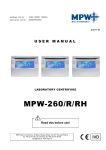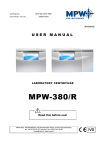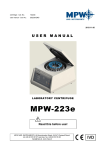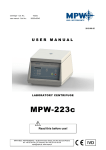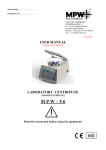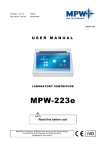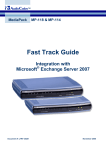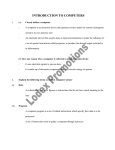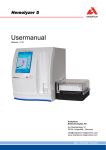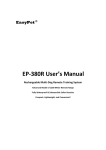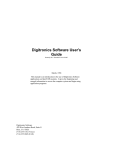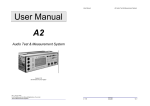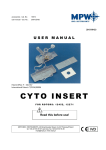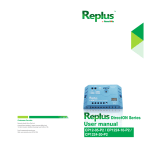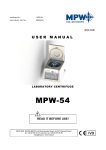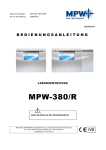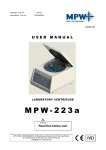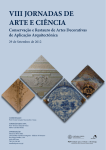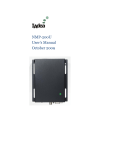Download MPW-380/R - MPW MED. INSTRUMENTS Spółdzielnia Pracy
Transcript
1 centrifuge - Cat. No.: user manual - Cat. No.: 10380, 10380R 20380/R/ENG 2012-06-12 USER MANUAL LABORATORY CENTRIFUGE MPW-380/R Read this before use! MPW Med. instruments, 46 Boremlowska Street, 04-347 Warsaw/Poland tel. +48 22 610 81 07 (service), fax +48 22 610 55 36 [email protected], www.mpw.pl Warning sings and hazard icons. WARNING! Warning of potential injury or health risk. DANGER! Risk of electric shock with potential for severe injury or death as a consequence. DANGER! Biohazard with potential for risk to health or death as a consequence. DANGER! Risk of explosion with potential for severe injury or death as a consequence. Statement of Conformity: The following machine is in accordance with the regulations of the EU Directive 98/79/EC and with the harmonized standards PN-EN 61010-1 and PN-EN 61010-2-020. 2 Contents 1. APPLICATION. ..................................................................................................................................................................... 5 2. TECHNICAL DATA. .............................................................................................................................................................. 5 2.1. ACCESSORIES. ................................................................................................................................................................... 6 2.1.1. Basic accessories (delivered with every centrifuge). ................................................................................................. 6 2.1.2. Optional accessories. ................................................................................................................................................. 6 2.2. EXPLOITATION MATERIALS. ............................................................................................................................................. 9 3. INSTALLATION. .................................................................................................................................................................. 10 3.1. UNPACKING OF THE CENTRIFUGE. ................................................................................................................................. 10 3.2. LOCATION........................................................................................................................................................................ 10 3.3. CONNECTION TO MAINS. ................................................................................................................................................. 10 3.4. CURRENT PROTECTION. .................................................................................................................................................. 10 4. DESCRIPTION OF THE CENTRIFUGE. ......................................................................................................................... 11 4.1. GENERAL DESCRIPTION. ................................................................................................................................................. 11 4.2. SERVICE ELEMENTS. ....................................................................................................................................................... 11 5. SAFE WORKING CONDITIONS. ...................................................................................................................................... 12 5.1. SERVICING PERSONNEL. .................................................................................................................................................. 12 5.2. GUARANTEE AND OPERATIONAL USE PERIOD. ............................................................................................................... 12 5.3. SAFEKEEPING PERIOD. .................................................................................................................................................... 12 5.4. HINTS ON CENTRIFUGING. .............................................................................................................................................. 12 5.5. HAZARDS AND PRECAUTIONS .......................................................................................................................................... 13 6. OPERATION OF THE CENTRIFUGE. ............................................................................................................................. 14 6.1. MOUNTING OF THE ROTOR AND ACCESSORIES. ............................................................................................................. 14 6.2. CONSTRUCTION AND SAFETY MEASURES. ...................................................................................................................... 15 6.3. DRIVE............................................................................................................................................................................... 15 6.4. DATA INPUT AND OUTPUT. .............................................................................................................................................. 15 6.5. CONTROLS. ...................................................................................................................................................................... 15 6.6. SAFETY DEVICES. ............................................................................................................................................................ 16 6.6.1. Cover lock. ............................................................................................................................................................... 16 6.6.2. Unbalanced load checking system. ......................................................................................................................... 16 6.6.3. Rotor installation and software compatibility verification unit. ............................................................................ 16 6.6.4. Rest state inspection. ............................................................................................................................................... 16 6.6.5. Checking of excessive temperature. ........................................................................................................................ 16 7. DESCRIPTION OF THE CENTRIFUGE OPERATING ELEMENTS........................................................................... 17 7.1. CONTROL PANEL. ............................................................................................................................................................ 17 7.2. DISPLAY. .......................................................................................................................................................................... 18 7.2.1. Variations of the main screen ................................................................................................................................. 19 7.3. SETTING UP PARAMETERS ............................................................................................................................................... 19 7.4. DESCRIPTION OF ZONES .................................................................................................................................................. 21 7.4.1. Speed ........................................................................................................................................................................ 21 7.4.2. Rcf ............................................................................................................................................................................ 21 7.4.3. Time ......................................................................................................................................................................... 22 7.4.4. Temp (Temperature) ............................................................................................................................................... 23 7.4.5. Prog (User’s programs) ........................................................................................................................................... 23 7.4.6. List of the user programs ........................................................................................................................................ 24 7.4.7. Program of preliminary refrigerating .................................................................................................................... 25 7.4.8. Changing acceleration/deceleration characteristics (numbers ACC/DEC 10 19)............................................. 26 7.4.9. Rotor/ Bucket ........................................................................................................................................................... 26 7.4.10. List of rotors .......................................................................................................................................................... 26 7.5. PARA – ZONE OF SETUP OF OPERATIONS’ PARAMETERS ................................................................................................ 27 7.5.1. Description of the function in the Para fold ........................................................................................................... 28 7.5.2. Acceleration and Deceleration characteristics. ...................................................................................................... 28 7.5.3. Radius ...................................................................................................................................................................... 29 7.5.4. Densi – sample density ............................................................................................................................................ 29 7.5.5. Cooling – refrigerating of the centrifuge chamber ................................................................................................ 30 3 7.5.6. Open lid after run – Automatic opening of the cover after the centrifuging is finished ....................................... 31 7.5.7. Start Delay – delayed start of centrifuging ............................................................................................................. 31 7.6. CONFIG – CONFIGURATION MENU OF THE CENTRIFUGE ................................................................................................ 31 7.6.1. Code ......................................................................................................................................................................... 32 7.6.2. Language – choice of the language ........................................................................................................................ 34 7.6.3. Screen – choice of the mode of the basic screen .................................................................................................... 34 7.6.4. Time / Date – setting the time and date................................................................................................................... 34 7.6.5. Cycles ....................................................................................................................................................................... 35 7.6.6. Rotating time – parameters of the centrifuging time.............................................................................................. 36 7.6.7. Buzzer ....................................................................................................................................................................... 36 7.6.8. Sensor – diagnostics of sensors and components errors ........................................................................................ 36 7.6.9. Reset – deleting all programs, the user settings and restoring of the default settings ........................................... 38 7.6.10. Curves – acceleration and deceleration curves..................................................................................................... 39 7.6.11. Rotor Runtime – preview of the quantity of the working cycles and the centrifuging time for each rotor ........ 44 7.6.12. 10 – Cycles – preview of spinning parameters of 10 last cycles ........................................................................... 44 7.6.13. Contact Us – fold with data of the MPW company .............................................................................................. 45 7.7. STARTING OF CENTRIFUGING.......................................................................................................................................... 45 7.7.1. Errors screens .......................................................................................................................................................... 46 7.7.2. Stabilization of the temperature of the centrifuge .................................................................................................. 48 7.7.3. Screens informing about the end of centrifuging ................................................................................................... 48 7.7.4. Additional messages ................................................................................................................................................ 49 7.8. CHANGE OF SETTINGS IN ZONES ..................................................................................................................................... 49 7.9. UNBALANCE ..................................................................................................................................................................... 50 7.10. EMERGENCY STOP ......................................................................................................................................................... 50 7.11. COMPLETION OF THE CENTRIFUGING .......................................................................................................................... 50 7.12. MATHEMATICAL RELATIONS. ....................................................................................................................................... 50 7.12.1. RCF – relative centripetal force. ........................................................................................................................... 50 7.12.2. Nomograph of relationship - rotational speed/centrifuging radius/RCF – Drawing No. 5. ............................... 50 7.12.3. Maximum load. ...................................................................................................................................................... 50 7.13. TEMPERATURE IN ROTATIONAL CHAMBER. ................................................................................................................. 51 8. CLEANING, DISINFECTION, MAINTENANCE. ............................................................................................................ 52 8.1. CLEANING OF THE CENTRIFUGE. .................................................................................................................................... 52 8.2. CLEANING OF THE ACCESSORIES. ................................................................................................................................... 52 8.3. LUBRICATION. ................................................................................................................................................................. 52 8.4. GLASS TUBE CRACKING. .................................................................................................................................................. 52 8.5. STERILIZATION AND DISINFECTIONS OF THE ROTATING CHAMBER AND ACCESSORIES. .............................................. 53 9. EMERGENCY CONDITIONS – SERVICE. ...................................................................................................................... 54 9.1. FAULT FINDING. ............................................................................................................................................................... 54 9.2. WORK SAFETY INSPECTION............................................................................................................................................. 56 9.3. INSPECTION PROCEDURES CARRIED OUT BY THE OPERATOR. ....................................................................................... 56 10. REPAIR CONDITIONS. ..................................................................................................................................................... 57 11. DISPOSAL........................................................................................................................................................................... 57 12. MANUFACTURER’S DATA. ........................................................................................................................................... 57 13. DISTRIBUTOR INFORMATION. .................................................................................................................................... 57 14. APPENDIX. .......................................................................................................................................................................... 58 14.1. NOMOGRAPH. ................................................................................................................................................................ 58 14.2. TABLE OF CHEMICAL RESISTANCE TO THE INTERACTION OF VARIOUS CATEGORIES OF REAGENTS OF PLASTICS ... 59 14.3. PRINTING OF CENTRIFUGATION PARAMETERS PROTOCOL THROUGH RS 232 PORT ................................................ 60 Annexes: Statement of conformity Declaration of decontamination (repair) Declaration of decontamination (returning device) 4 1. Application. The MPW-380/R centrifuges are table top laboratory centrifuges for in vitro diagnostic (IVD). MPW-380R is equipped with cooled rotating chamber, used to separation of samples took from people's, animal’s and plant’s components with different densities, under the influence of the centrifugal force, to provide information about their biological state (MPW-380 – without cooling). Its construction ensures easy operation, safe work and wide range of applications at laboratories engaged in routine medical analyses, biochemical research works etc. This centrifuge is not biotight and therefore during centrifugation of preparations requiring biotightness one has to use closed and sealed containers and rotors. In the centrifuge, it is prohibited to centrifuge caustic, inflammable and explosive preparations. 2. Technical data. manufacturer type cat no. mains voltage mains frequency connected load current protection cooling medium capacity (max.) speed – RPM force – RCF kinetic energy (max.) running time counting short-time operation mode continuous operation mode operation programs operating temperature precooling** cooling without acceleration curves deceleration curves adjustable curves: MPW Med. instruments 46 Boremlowska Street, 04-347 Warsaw, Poland MPW - 380 MPW - 380R 10380 10380R 230V 115 V 230 V 230 V 115 V 50/60 Hz 50 Hz 60 Hz 60 Hz 0,8 kW 1,3 kW 10 A 12 A 14 A 14 A 16 A --R507* 1600 ml 100 18000 (10s resolution) 31150 x g 19559 Nm 5 s 9 min 59 s (1s resolution), 10 min 9 godz 59 min (1min resolution) till start, effective centrifuging time calculation yes yes 99 … ÷ 40ºC -20 ÷ 40ºC no yes, 2500 RPM, 4ºC no yes 10 (linear) 10 (linear) acceleration 10 curves (4 points) deceleration 10 curves (4 points) USB interface EMC ambient conditions (PN-EN 61010-1 1.4.1) set-up site ambient temperature humidity (maximum relative humidity) excess-voltage category pollution degree safety area dimensions width depth height noise level weight * CFC, HCFC free ** program no. 1 *** option yes*** PN-EN 55011 II 2 indoors only 5º ÷ 40ºC < 80% (PN-EN 61010-1) (PN-EN 61010-1) 300 mm 515 mm 650 mm 455 mm 715 mm 650 mm 455 mm 56 dB ~ 74 kg 5 ~ 112 kg 2.1. Accessories. 2.1.1. Basic accessories (delivered with every centrifuge). Cat. No. 17798 17799 17642 17009 17010 20380/R/ENG Accessories Complete clamp Spanner for the rotor Spanner for emergency opening of the cover Power cord 230 V Power cord 115 V (optionally) User manual pcs 1 pcs 1 pcs 1 pcs 1 or pcs 1 pcs 1 2.1.2. Optional accessories. Depending on customer’s needs the MPW-380/R centrifuge can be provided with below specified accessories: ANGLE ROTORS Rotor capacity Angle rotor HSL 45o 30 x 2,0/1,5 ml rmax rmin [cm] [cm] 16400 29168 9,7 6,5 Angle rotor HSL 45 o 36 x 2,0/1,5 ml 18000 30065 8,3 5,0 45 o 48 x 2,0/1,5 ml 16400 28265 9,4 6,2 45 o 12 x 8 x 0,2 ml PCR strip 16400 28566 9,5 8,4 45 o 12 x 10 ml/81 mm 18000 31150 8,6 5,0 30 o 12 x 10 ml/100 mm 14000 20598 9,4 5,0 45 o 60 x 2,0/1,5 ml 16400 29168 9,7 6,5 30 o 12 x 15 ml Falcon 14000 23227 10,6 4,6 30 o 8 x 30 ml Nalgene (25x98) 17500 29787 8,7 3,2 30 o 6 x 50 ml Nalgene (28x106) 14500 21625 9,2 3,0 30 o 8 x 50 ml Nalgene 14000 21255 9,7 5,0 30 o 8 x 50 ml Falcon 14000 23666 10,8 5,0 25 o 4 x 250 ml 10000 14086 12,6 5,7 30 o 6 x 94/85 ml Nalgene 12000 17710 11,0 4,0 45 o 36 x 2,0 ml Filter 15000 22136 8,8 5,0 30 o 12 x 50 ml Falcon 4500 3328 14,7 8,3 30 o 36 x 15 ml Falcon 5000 3996 14,3 6,0 30 o 48 x 15 ml Falcon 4700 4025 16,3 8,0 Type of rotor 11761 11762 11763 11765 11766 11767 11769 11770 11772 11773 11775 11776 11777 11778 11779 11780 11784 11785 Max RCF rpm Angle Cat. No Angle rotor HSL Angle rotor HSL Angle rotor HSL Angle rotor HSL Angle rotor HSL Angle rotor HSL Angle rotor HSL Angle rotor HSL Angle rotor HSL Angle rotor HSL Angle rotor HSL Angle rotor HSL Angle rotor HSL Angle rotor Angle rotor Angle rotor HS – hermetically sealed HS accessories maintenance. Make sure that rubber O-rings are lightly coated with silicone grease. Use high vacuum grease, e.g. type „C” by LUBRINA. 6 SWING-OUT ROTORS Max RCF rpm rmax rmin [cm] [cm] 14500 16450 7,0 3,0 Cat. No Type of rotor Rotor capacity 12768 6 adapters 20 x 0,4/0,2 ml 12786 Swing-out drum rotor Swing-out rotor or 10 x 2,0/1,5ml 4 x 250 ml 5000 4724 16,9 12,4 12787 Swing-out rotor 2 x 3 micro titer plates and blocks 4300 2398 11,6 5,5 12788 12791 Swing-out rotor Swing-out rotor 4 x 4 micro titer plates and blocks 4000 2500 2826 1292 15,8 18,5 10,0 4,0 12830* Swing-out rotor 4x400ml, (48x15ml, 48x15ml Falcon, 8x100 ml) 4500 4188 18,5 8,5 4 x ASTM * - 4000 rpm, RCF = 3309 for MPW-380 BUCKETS Catalog no 13080 13081 13174 13178c 13180 13275c 13276 13580 13286 13789 13792c 13831c 13833c 13865 13866 Application Bucket 17,7x87 mm for15/10/7/6 ml test tubes for rotor 11784, 11785; Bucket 17,7x65 for 10/6/5 ml test tubes for rotor 11784, 11785; Round bucket 62x107 mm for 250 ml bottles for rotor 12786; Round bucket 62x107 mm for 250 ml bottles with cap 17179 for rotor 12786; Bucket 30x99 mm for 2 x 50 ml Falcon test tubes for rotor 12786; Bucket 30x99 mm for 50/30/25 ml Falcon test tubes with cap 17151 for rotor 11780; Bucket 30x96 mm for 50/30/25 ml Falcon test tubes without thread for rotor 11780; Bucket 45x116 mm for 2 glass test tubes 50ml for rotor 12786; Bucket 85x130x60 mm for 2-5 microtiter plates and block for rotor 12787; Bucket 85x130x60 mm for 1-4 microtiter plates and block for rotor 12788; Bucket for ASTM with cap 17792 for rotor 12791; Rectangular bucket with cap 17832 for rotor 12830; Round bucket 400 ml with cap 17834 for rotor 12830; Bucket for 7 test tubes 50 ml Falcon for rotor 12830; Bucket for 6 test tubes 50 ml Falcon for rotor 12830; ROUND CARRIERS Catalog no. 14000 14002 14017 14036 14043 14047 14071 14082 14084 14089 14126 14133 14151 14152 14153 14154 14155 14156 Application Adapter 20x0,4 ml for rotor 12768; Adapter 10x2,0/1,5 ml for rotor 12768; Pad for 250 ml round-bottom bottles for rotor 12177 and buckets 13174, 13178; Round carrier 28,5 special test tube ml (13,5x92 mm) for rotor 11469, 11773, 11775 Round carrier 29 for test tubes 5 ml (13x85) for rotor 11457, 11776; Round carrier 16,8 for test tubes 5 ml (13x85) for rotor 11466, 11770; Round carrier for 30 ml test tubes nr 15055 ( 25x100 mm) for rotor 11776; Round carrier 17,6 for 7/5 ml test tubes ( 13,3x100 mm) for bucket 13080 and 13081; Round carrier 11,0 for 0,5 ml test tubes ( 8,0x30 mm) for rotor 11761, 11762, 11763; Round carrier 29,0 for 15 ml Falcon test tubes ( 17x120 mm) for rotor 11780 and bucket 13275, 13276; Round carrier 11 for 0,4 ml test tubes (5,8x46 mm) for rotor 11761, 11762, 11763; Round carrier 10,8 for 0,2 ml test tubes (6,2x21 mm) for rotor 11761, 11762, 11763; Round carrier 61 for 1x100 ml test tubes ( 46x100 mm) for bucket 13174, 13178; Round carrier 61 for 1x50 ml Falcon test tubes ( 30x120 mm) for bucket 13174, 13178; Round carrier 61 for 5x15 ml Falcon test tubes ( 17/22x120 mm) for bucket 13174, 13178; Round carrier 61 for 9x 5 ml test tubes ( 13,5/17x81 mm) for bucket 13174, 13178; Round carrier 61 for 12x7/5 ml test tubes ( 13/14,5x100 mm) for bucket 13174, 13178; Round carrier 61 for 8x14/10 ml test tubes ( 17/17,7x113 mm) for bucket 13174, 13178; 7 14157 14158 14159 14160 14188 14248 14793 14794 14795 14836 14837 14838 14839 14840 14841 14842 14844 14845 14846 14847 14848 14849 14850 14851 14853 14854 14855 14856 14859 14860 14862 14864 Round carrier 61 for 4x15 ml test tubes ( 17/22x120 mm) for bucket 13174, 13178; Round carrier 61 for 12x2,0 ml Eppendorf test tubes ( 11x43 mm) for bucket 13174, 13178; Round carrier 45 for 1x50 ml test tubes ( 35,5x100 mm) for bucket 13833 and round carrier 14850 and buckets 13174, 13178 and round carrier 14151; Round carrier 61 for 3x30/25 ml test tubes ( 25,5x100 mm) for bucket 13174, 13178; Pad for 100/50 ml test tubes for round carrier 14841; Round carrier 29,8 for 30/25 ml test tubes ( 26x100 mm) for bucket 13275 and 13276; Round carrier 83x95 mm test tubes 13x15 ml Falcon ( 17x120 mm) for bucket 13831; Round carrier for ASTM laboratory ware of 160 mm lengths 15797; Round carrier for ASTM laboratory ware of 167 mm lengths 15796; Round carrier 83x95 mm for 24x5 ml test tubes ( 13x75 mm) for bucket 13831; Round carrier 83x95 mm for 16x10 ml test tubes ( 17x100 mm) for bucket 13831; Round carrier 83x95 mm for 12x15 ml test tubes ( 17x120 mm) for bucket 13831; Round carrier 83x95 mm for 8x30 ml test tubes ( 26x102 mm) for bucket 13831; Round carrier 83x95 mm for 5x50 ml test tubes ( 30x120 mm) for bucket 13831; Round carrier 83x95 mm for 2x100 ml test tubes ( 45x103 mm) for bucket 13831; Round carrier 83x95 mm for 250 ml bottle ( 62x135 mm) for bucket 13831; Round carrier 83x95 mm for 26x2,0 ml test tubes ( 11x43 mm) for bucket 13831; Round carrier 84 mm for 18x5 ml test tubes ( 13,5x75 mm) for bucket 13833; Round carrier 84 mm for 12x10 ml test tubes ( 17x100 mm) for bucket 13833; Round carrier 84 mm for 12x15 ml test tubes ( 17x120 mm) for bucket 13833; Round carrier 84 mm for 5x30 ml test tubes ( 26x102 mm) for bucket 13833; Round carrier 84 mm for 4x50 ml test tubes ( 30x120 mm) for bucket 13833; Round carrier 84 mm for 100 ml test tubes ( 45x103 mm) for bucket 13833; Round carrier 84 mm for 250 ml bottle ( 62x135 mm) for bucket 13833; Round carrier 84 mm for 24x2,0 ml test tubes ( 11x43 mm) for bucket 13833; Round carrier 84 mm for 200 ml bottle ( 57x113 mm) for bucket 13833; Round carrier 38 mm for 50 ml Falcon test tubes ( 30x120 mm) for rotor 11778; Round carrier 38 mm for 15 ml Falcon test tubes ( 17x120 mm) for rotor 11778, Round carrier 84 for test tubes 3x50 ml ( 35x100 mm) for bucket 13833; Round carrier 83x95 for test tubes 28x1,2 ml S-Monovette ( 9x82,3 mm) for bucket 13831; Round carrier 83x95 for test tubes 25x5 ml ( 13,1x100 mm) for bucket 13831; Round carrier 38 for test tubes 24x1,2 ml S-Monovette ( 9x82,3 mm) for bucket 13833; TEST TUBES Catalog no 15011 15016 15017 15015 15040 15046 15048 15050 15051 15052 15053 15054 15055 15056 15067 15102 15115 Specification Polypropylene round-bottom test tube 2 ml with cap ( 10,8x40 mm); Polypropylene test tube 1,2 ml s-Monovette ( 8,8/13,3x82,3 mm); Polycarbonate round-bottom bottle 250 ml (62x122 mm); Polypropylene test tube 2 ml with cap ( 10,8x41,2 mm); Polypropylene test tube 100 ml with cap ( 44,5x103 mm); Polypropylene test tube 14 ml with cap ( 16,8x113 mm); Polypropylene test tube 15 ml Nalgene ( 16x113 mm); Polypropylene test tube 15 ml Falcon ( 17/21x120 mm); Polypropylene test tube 50 ml Nalgene ( 28,8x106,7 mm); Polypropylene test tube 50 ml Falcon ( 30/35x120 mm); Polypropylene test tube 10 ml with cap ( 16/19x100 mm); Polypropylene test tube 6 ml with cap ( 11,5x92 mm); Polypropylene test tube 30 ml with cap ( 24,8x100 mm); Polycarbonate test tube 30 ml Nalgene with cap ( 25,5x94 mm); Polycarbonate test tube 85 ml Nalgene with cap ( 37,8x106 mm); Micro titer plate with cap (85,5x127 mm); Glass tube 100 ml ( 45x100 mm); 8 15116 15118 15119 15120 15121 15122 15124 15125 15127 15128 15130 15131 15175 15176 15419 15424 15440 15796 15797 15852 Glass tube 50 ml ( 35x100 mm); Glass tube 10 ml ( 16x100 mm); Glass tube 7 ml ( 12x100 mm); Glass tube 5 ml ( 12x75 mm); Polypropylene test tube 10 ml with stopper ( 17x70 mm); Polypropylene PCR test tube 8x0,2 ml ( 6x21 mm); Polypropylene test tube 0,4 ml ( 5,7x46 mm); Polypropylene test tube 0,2 ml PCR ( 6x21 mm); Polypropylene test tube 0,5 ml with cap ( 7,8x30 mm); Polypropylene test tube 1,5 ml with cap ( 10,8x39 mm); Polypropylene PCR test tube 8x0,2 ml ( 6x21 mm); Polypropylene PCR test tube 4x0,2 ml ( 6x21 mm); Polypropylene bottle 250 ml Herolab ( 61,5x125 mm); Polycarbonate bottle 250 ml Herolab ( 61,5x135 mm); Polypropylene test tube 5 ml ( 12x75 mm); Polypropylene test tube 30 ml Nalgene with cap ( 25,5x94 mm); Polypropylene bottle 200 ml ( 56,5x113 mm); Glass centrifugal vessel ASTM cylindrical, in the lower part conical lengths 167 mm BRAND no 3623 38; Glass centrifugal vessel ASTM in the shape of the pear, in the lower part conical lengths 160 mm BRAND no 3621 38; Polypropylene bottle 400 ml ( 84x135 mm); OTHER ACCESSORIES Catalog no Specification 16412 16594 16595 17151 17179 17792 17832 17834 Locker under centrifuge Data recording set of working parameters by serial RS 232 pin; Thermal printer of working parameters by serial RS 232 pin; Polycarbonate cap for bucket No. 13275; Aluminum cap for bucket No. 13178; Aluminum cap for bucket No. 13792; Polycarbonate cap for bucket No. 13831; Aluminum cap for bucket No. 13833; CAUTION! “” manufactured for individual order. 2.2. Exploitation materials. For operating in centrifuge one should use only original company’s buckets comprised in the specification of accessories as well as test-tubes for centrifuges of proper diameter, length and strength. Utilization of test-tubes of other makes shall be agreed upon with manufacturer of the centrifuge. For cleaning and disinfecting one should use agents generally applied in the health service, such as e.g. Aerodesina-2000, Lysoformin 3000, Melseptol, Melsept SF, Sanepidex, Cutasept F. 9 3. Installation. 3.1. Unpacking the centrifuge. Open the package. Take out the cardboard box containing the accessories. Take out the centrifuge from the package. Keep the package and packing materials at hand for service transport. 3.2. Location. The centrifuge shall not be located near the radiators and shall not be subjected to direct sunlight. The table for the centrifuge shall be stable and shall have flat-levelled table top. It is necessary to ensure a safety zone of the minimum 30 cm round the centrifuge from every direction. Normal operating conditions ambient temperature is from 15 C to 35 C. Passed parameters of the centrifuge are referring to the above named temperatures. At the change of the place from cold to warm one, condensation of water will occur inside the centrifuge. It is important then that sufficient time be provided for drying the centrifuge prior to starting the centrifuge again (minimum 4 hours). 3.3. Connection to mains. Supply voltage given on the rating plate has to be consistent with local supply voltage. MPW Med. instruments laboratory centrifuges are 1st safety class devices and they are provided with the threecore cable with the plug resistant to dynamic loadings. Mains socket shall be provided with the safety pin. It is recommended to install emergency cut-out that shall be located far from the centrifuge, near the exit or beyond the room. Supply voltage 230 V 50 Hz, optionally 230 V 60 Hz, 115 V 60 Hz. Before switching on, check whether the centrifuge is connected to power supply correctly. Check centrifuge before usage whether she is installed correctly. 3.4. Current protection. The centrifuge has thermal current protection of 14 A values 230V (TA 45 A124 L140U3), optionally 16A 115V (TA 45 A124 L160U4) is situated in the power switch on the left side of the centrifuge. 10 4. Description of the centrifuge. 4.1. General description. New generation of MPW Med. instruments laboratory centrifuges is provided with state-of-the-art microprocessor control systems, very durable and quiet asynchronous brushless motors and accessories consistent with requirements of the present-day user. 4.2. Service elements. 1. Cover 2. Inspection glass 3. Control panel 4. Emergency cover open place 5. Power switch Drawing 1. General view MPW-380 MPW-380R 4 3 2 1. Motor axle 1 2. Rotor 1 2 3. Rotor cover 4. Complete clamp 1. RS 232 socket 2. Plug-in socket Drawing 3. Unit elements of the angle rotor Drawing 2. Back of the centrifuge 11 5. Safe working conditions. 5.1. Servicing personnel. The MPW-380/R laboratory centrifuge can be operated by laboratory personnel after getting acquainted with User manual. User manual shall be held all the time near the centrifuge. User manual must be kept always at hand!!! 5.2. Guarantee and operational use period. Guarantee period amounts to minimum 24 months. Principles are specified in guarantee certificate. The service life of the centrifuge specified by the manufacturer amounts to 10 years. After termination of guarantee period it is necessary to carry out yearly technical inspections of the centrifuge. Only service personnel authorized by manufacturer may perform the inspections. The manufacturer reserves the right to make modifications to produced goods. 5.3. Safekeeping period. Maximum period of storage of not used centrifuge amounts to 1 year. After this period, a service authorized by manufacturer should carry out technical inspection of the centrifuge. 5.4. Hints on centrifuging. Set the centrifuge in horizontal position on rigid base. Ensure safe positioning location. Ensure free space around the centrifuge (amounting to at least 30 cm left free). Ensure sufficient ventilation. Fix the rotor on the motor axis firmly. Avoid unbalance. Load opposite buckets with the same accessories. Centrifugation of the test tubes of different sizes. There is a possibility to centrifuge test tubes of different sizes; however, it is absolutely necessary in such cases that opposite buckets and round carriers be the same. Not only the test tubes shall be inserted symmetrically, but also round carriers and their hangers shall be equally loaded. It is e.g. not allowed to operate centrifuge only external part of reductive insert loaded. 12 It is necessary to insert test tubes symmetrically on the opposite sides. Fill test tubes outside the centrifuge. Please pay special attention to the quality and proper thickness of the glass test tubes walls. Those shall be test tubes for centrifuges, of proper durability up to 5,000 x g. In order to protect the centrifuge against unbalance, fill in the test tubes up to the same weight. Lubricate the swing-out rotor journal pins. Use only accessories in good condition. Protect equipment against corrosion using accurate preventive maintenance. Infectious materials could be processed in closed buckets only. It is not allowed to centrifuge explosive and inflammable materials. It is not allowed to centrifuge substances prone to reacting in result of supplying high energy during centrifugation. 5.5. Hazards and precautions Prior to switching the centrifuge on, one shall read carefully all sections of this instruction in order to ensure smooth operation and avoid damages of this device or its accessories. Centrifuge shall not be operated by unqualified personnel. Centrifuge must not be transported with the rotor mounted on the shaft. One must use original rotors, test-tubes and spare parts only. In the case of faulty operation of the centrifuge one shall ask for assistance of service of MPW Med. instruments Company or its authorized representatives. It is not allowed to switch the centrifuge on if it is not installed properly or rotor is not fitted correctly. The centrifuge must not be operated in places where explosion hazard exists as it is not explosion-proof. It is not allowed to centrifuge materials capable of generating inflammable or explosive mixtures when subjected to air. It is not allowed to subject to centrifugation toxic or infectious materials with damaged leak proof seals of the rotor or test-tube. Proper disinfection procedures have to be carried out when dangerous substances contaminated the centrifuge or its accessories. 13 It isn't allowed to open the cover manually in emergency procedure when rotor is still turning. It isn't allowed to exceed load limit set by the manufacturer. Rotors are intended for fluids of average homogeneous density equal to 1.2 g/cm3 or smaller when centrifugation is carried out at maximum speed. When fluids of higher density shall be used, then it is necessary to enter the value in the PARA fold (see point 7.5.4. “Density” and also point 7.12.3 “Maximum load”). It is not allowed to use the rotors and round carriers with signs of corrosion or other mechanical defects. It is not allowed to centrifuge highly corrosive substances which may cause material impairment and lower mechanical properties of rotor and round carriers. It isn’t allowed to use rotors and accessories not admitted by the manufacturer. Let to use commercial glass and plastic test tubes, which are destined to centrifuging in this laboratory centrifuge. One should absolutely not use poor quality elements. Cracking of glass vessels and test tubes could result in dangerous vibration of the centrifuge. It is not allowed to carry out centrifugation with the rotor caps taken off or not driven tight. It is not allowed to lift or shift the centrifuge during operation, and rest on it. It is not allowed to stay in the safety zone within 30 cm distance around the centrifuge neither leave within this zone some things, e.g. glass vessels. It is not allowed to put any objects on the centrifuge. 6. Operation of the centrifuge. 6.1. Mounting of the rotor and accessories. 1. 2. 3. 4. 5. 6. 7. 8. 9. 10. 11. 12. 13. Connect the centrifuge to the mains (master switch on left side of the centrifuge). Open the cover of the centrifuge by pressing the COVER key. Prior to putting the rotor in, one has to check if the rotating chamber is free of impurities, e.g. such as dust, glass splinters, residues of fluids that must be taken away. One shall fit the rotor on the motor shaft driving it home on the cone. Caution! Fitting the rotor too shallow will result in lack of identification of the rotor after start of the centrifuge, displaying the error message (see p. 7.7.1.) and stopping the centrifuge. Screw-in the bolt for fixing the rotor (clockwise) and screw it tightly home with the supplied spanner for the rotor. Swing-out rotors have to be provided with the buckets in all seats. One should remember that every buckets swings individually. Bucket suspension studs should be lubricated periodically with technical petroleum jelly. In the case of rotors designed with the cover they must not be used without it. Rotor covers must be closed exactly. Rotor covers ensure smaller drags of the rotors, proper setting of the test-tubes and airtight sealing. One should use only buckets intended for selected types of the rotor – see p. 2.1. “Accessories”. Fill test tubes outside the centrifuge. Put on or screw the caps on vessels and rotors (if applicable). In the case of centrifuging in an angle rotor, test tubes (buckets) have to be filled properly in order to avoid overflows. CAUTION: Centrifuge will tolerate small weight differences occurring during loading of rotors. However it is recommended to equalize vessels loads as much as possible in order to ensure minimal vibrations during operation. When the centrifuge is started with large imbalance, the unbalance control system will switch-off the drive system and error signal will be transmitted. On the monitoring panel, error message will be displayed (see p. 7.7.1.). In order to prolong lifetime of the rotor and gaskets rotors shall be lubricated with the maintenance oil, while gaskets and threaded parts shall be lubricated with the technical petroleum jelly. For replacement of the rotor one shall unscrew clamping and then grab the rotor with both hands at opposite sides, taking it away from drive shaft by pulling it up. 14 6.2. Construction and safety measures. The centrifuge has rigid self-supporting structure. Housing was made of sheet aluminium, back made of steel sheet. Front and cover was made of ABS type plastic. Cover is fixed on steel axles of hinges and from the front it is locked with two electromagnetic locks blocking possible opening during centrifugation. Rotation chamber casing was made of thick steel sheet. The rotation chamber bowl is made of stainless steel sheet. Rotors and containers are from aluminium, lids from polycarbonate and reductive inserts from the polypropylene. 6.3. Drive. Low noise induction motor constitutes the drive. 6.4. Data input and output. Data setting and read-out system forms hermetically closed keyboard with distinctly accessible operation points. Easily readable displays signalling individual performed operations facilitate operator’s programming and recording of parameters and condition of the centrifuge. The centrifuge is provided with the RS 232 serial interface that enables connection of the centrifuge to external PC unit with the printer and recording the centrifugation parameters. 6.5. Controls. The microprocessor control unit of the centrifuge ensures broad possibilities of providing, realisation and reading of work parameters, that is: selection of the spin program from the list 1÷99 (looking through of programs); selection of the rotor and containers tied with him according to the accession number from the list (looking through of rotors and their parameters); setting the rotational speed within 100 18,000 rpm at 10 rpm interval; setting the RCF with automatic calculation of the rotation speed with 10 rpm accuracy. setting centrifugation time: 5 sec ÷ 9 min. 59 sec. (resolution 1 sec.) 10 min. ÷ 9 h 59 min. (resolution 1 min.) or continuous running HOLD selection of SHORT – short duration operation, Stand By function – display unit blanking after 10 seconds of idle, counting the time of the START key pressing or of the set speed reached; displaying the increasing or reducing time by the choice, selecting acceleration characteristics from 0 – quickest to 9 – slowest with displaying the time in [s], selecting deceleration characteristics from 0 – quickest to 8 – slowest; deceleration characteristics number 9 is subterfuge characteristics (with time of free stopping of the rotor in [s]), programming of optional acceleration and deceleration time, programming of multi-segment characteristics of the working cycle with graphical visualisation, setting the rotation chamber temperature: - 20° ÷ + 40° C (reached temperature -13C +40C) MPW-380R selection of the COOLING option – cooling the rotation chamber after the end of centrifuging MPW-380R , selection of the program no. 1 – cooling the rotation chamber and accessories before start of centrifuging, selecting the AUTO COVER function – automatic opening of the cover after centrifuging is finished, setting the START DELAY option (time settings), setting the RADIUS option – changing of rotor radius [mm], setting the DENSITY option – changing of sample density [g/cm3], 15 setting the configuration menu access code, selection of menu language (polish, english, spanish) selection of the primary screen mode (display SPEED+RCF or SPEED only or RCF only), setting the DATE and TIME, preview of spinning parameters of 10 last cycles, preview of the total working time and quantity of the full working performed cycles, preview of the quantity of the working cycles and the centrifuging time for each rotors, possibility to switch the key signals on/off, possibility to register the centrifuging parameters by connecting the centrifuge to a PC with a printer or “Kawka” thermal printer, displaying information on emergency states. 6.6. Safety devices. Apart from the above described passive devices and safety measures there exist as well active devices and elements as follows: 6.6.1. Cover lock. The centrifuge can be started only with properly closed cover (the COVER diode is not shining). While, the cover can be opened only after stopping the rotor. In the case of emergency opening of the cover during operation, the centrifuge will be immediately switched-off and the rotor will brake till complete stopping. With opened cover (the COVER diode is shining), the drive is completely disconnected from the power, which makes it impossible to start the centrifuge. 6.6.2. Unbalanced load checking system. When loads of opposite buckets or carriers in rotors are unbalanced, the drive will be switched-off during acceleration or operation of the centrifuge – and the error message will be displayed (see p. 7.7.1.). 6.6.3. Rotor installation and software compatibility verification unit. Directly after starting centrifuging, a unit verifies the type of the rotor applied and in the case of its incompatibility with the type indicated in the application or absence of the rotor, the spinning process shall be stopped with simultaneous displaying the error message (see p. 7.7.1.). The conformity of the type of the rotor is signalled with a single audible signal. 6.6.4. Rest state inspection. Opening of the centrifuge’s cover is possible only with the rotor in the state of rest. When the rotor is being stopped, the STOP diode is on and goes off when it is stopped. 6.6.5. Checking of excessive temperature. MPW-380R If temperature in rotation chamber exceeds 50° C caused by, for example, malfunction of cooling system, drive will be switched off and error message will be displayed (see p. 7.7.1.). The reboot is only possible after chilling the device. 16 7. Description of the centrifuge operating elements. Power switching ON/OFF is carried out with master switch situated on left wall of the centrifuge. All settings on the centrifuge are done by means of the control panel. Panel comprises control keys, display and signaling LED’s. 7.1. Control panel. The control panel placed on the front casing serves the purpose of controlling centrifuge operation. 8 9 10 1 2 3 4 5 6 7 MPW-380 MPW-380R Drawing No.4.Control panel 1. COVER diode – is on when the cover is open, 2. COVER key – serves for opening the cover, 3. SHORT key – serves for short duration work (the centrifuge is working as long as the key is pressed), 4. START diode – is on of the moment of pressing the START key until pressing the STOP key, 5. START key – starting centrifugation with programmed parameters, 6. STOP diode – is on of the moment of pressing the STOP key until the rotor is stopped, 7. STOP key – serves for centrifuging stopping. Single-time pressing will make stopping centrifuging with acceleration characteristics set in the software. Pressing and holding it for 1s will make the centrifuging stop quicker. During setting of the parameters, it serves for exiting zones on the primary screen without introducing changes. 8. UP key – serves for the zone change on the display or for increasing the edited parameter 9. SET key – serves for entry to the edition of parameters and confirming the set parameter 10. DOWN key – serves for the zone change on the display or for reducing the edited parameter 17 7.2. Display. The display is located in the centre of the control panel. The main screen is presented below for MPW-380 and MPW-380R. MPW-380 1 2 9 3 10 11 4 5 6 12 7 8 13 14 15 MPW-380R 1 2 11 3 12 13 4 5 14 6 7 8 15 1. Assigned speed in [rpm] 2. Measured rotor speed in [rpm] 3. Assigned RCF 4. Measured RCF 5. Assigned value of the centrifuging time: h: min : sec 6. Zone mark of assigning of the centrifuging time: ZONE 1: 5 sec. – 9 min. 59 sec. [at 1 sec. intervals] ZONE 2: 10 min. – 9 h 59 min. [at 1 min. intervals] 7. Centrifuging time (cursor ↑) or time remaining to end of centrifuging (cursor ↓) 8. Cursor of counting of the centrifuging time: ↑ : displaying the centrifuging time (counting upwards) ↓ : displaying the time remaining to end of centrifuging 9. Assigned temperature: MPW-380R -20oC do +40oC 10. Measured temperature MPW-380R 18 9 16 10 17 11. Number of the user's program 12. List of the user's programmes 13. Number of the rotor / Number of the bucket 14. List of the rotors and buckets 15. Setting of work parameters of the centrifuge 16. Cursor of counting of the centrifuging time: the flashing dots mean counting pending 17. Configuration menu 7.2.1. Variations of the main screen Beside displaying the mode SPEED+RCF there is a possibility to set 2 extra modes of work: displaying only SPEED or only RCF. Switching to the suitable mode takes place on the CONFIG→ SCREEN fold. MPW-380 MPW-380R only SPEED only RCF only SPEED only RCF 7.3. Setting up parameters On the main screen, it is possible to set: SPEED, RCF, TIME, Temperature – TEMP MPW-380R , Selection of user’s program – PROG, Selection of user’s program from list (programmes browsing), Selection of rotor and bucket, Selection of rotor from list (browsing of rotors and their parameters), Assigning of PARA work parameters and CONFIG configuration of centrifuge. Assigning settings takes place in two stages: It is necessary in the first place to choose the zone, in which the parameters will be set. Available zones: SPEED, RCF, TIME, TEMP, PROG, PROG LIST, ROTOR NUMBER/BUCKET NUMBER, ROTORS LIST, PARA, CONFIG. The zone is selected by pressing the SET key (first from chosen zones will begin to blink; it is SPEED or RCF depending on the mode of work of the screen), and choosing the suitable zone with UP or DOWN keys. After choosing the zone, pressing the SET key again will cause proceeding to parameters setup. The settings may be changed with keys UP and DOWN accordingly. Pressing the SET key ends the setting and causes the chosen value to be entered to the driver’s register. 19 Exemplary change of TIME settings: a) press the SET key First zone (SPEED) will begin to blink b) press the UP key two times (selection of TIME zone) Blinking TIME zone c) press the SET key (starting the change setup in the TIME zone) The SET inscription is highlighted: mode of programming setups in the chosen zone Blinking altarpiece undergoing a change 20 d) increase or decrease the setup value with UP and DOWN keys. Pressing in and supporting the key longer than the second makes switching on repetition of key. If the key is still pressed for another 3 seconds, the speed of repetition is growing three times. New value of TIME setup e.g. 4min.12sec. e) pressing the SET key ends setting the new value of the centrifuge time New value of the centrifuge time is entered to the time-meter 7.4. Description of zones 7.4.1. Speed Rotational speed of the rotor. Set from 100 rpm (speed of identification of rotors is 85 rpm) to the maximum, admissible rotor speed. The settings are changed with UP and DOWN keys, in 10 rpm interval. Pressing and holding a key longer than one second switches the repetition on. If the key is still pressed for another 3 seconds, the speed of repetition grows ten times (to 100 rpm.). 7.4.2. Rcf The RCF calculation function is highly non-linear, hence setting the RCF takes place stepwise as per every 10 rpm. 21 7.4.3. Time Setting the centrifuging time is divided into 3 zones: I) range from 5 sec. to 9 min. 59 sec. by 1-sec. intervals. Setting in this zone is marked by “-----” mark under “min: sec” values . „-----” mark of time zone 5sec. - 9min.59sec. Minutes Seconds II) range from 10 min. to 9 h 59 min. in 1 min. interval. Setting in this zone is marked by “-----” mark under “h: min” values. „-----” mark of time zone 10min. – 9h 59min. Hours Minutes III) range of continuous work of the centrifuge (unlimited centrifuging time). When setting the centrifuging time longer than 9 h 59 min, instead of centrifuging time, the "HOLD" message is being displayed. It means that the centrifuge will be working until pressing the STOP key. „HOLD” message means continuous centrifuging 22 7.4.4. Temp (Temperature) MPW-380R Setting the temperature within the range from -20 oC to +40 oC, by 1 oC interval. (reached temperature -13C +40C) 7.4.5. Prog (User’s programs) Range of programs: from 1 to 99. The program chosen most recently is activated automatically when turning on the centrifuge. If none program was chosen or in the case of a change of the parameter without saving, the “--”sign is being displayed. It order to select the program: choose the PROG zone (press the SET key , chose zone with UP or DOWN keys; “PROG --” message will begin to blink) Blinking „PROG --”message 1. press the SET key and proceed to the selection of the program number (“--” sign or program number will begin to blink). With UP or DOWN keys choose the program number. Blinking program number. Choose with UP and DOWN keys finish setting the program number with the SET key. The only possibility to stop of the program used recently is removing it from the list of programs (see p. 7.4.6) or setting another program. 23 7.4.6. List of the user programs The centrifuging parameters: SPEED, RCF, TIME, TEMP, acceleration characteristics, deceleration characteristics and rotor number may be saved and then loaded by the user (saving as one of 99 available programs). In order to browse the list of programs: choose the PROG zone (press the SET key, chose zone with UP or DOWN keys; cursor of PROGRAM LIST will begin to blink) Blinking cursor of PROGRAM LIST press the SET key and proceed to browse the list of programs Marker of the loaded program number Centrifuging time Program number Set speed Marker of selected program Rotor number Deceleration characteristic Acceleration characteristic Set temperature ATTENTION! In case of deleting all user programs, when no. 1 program is currently active (default program), please follow the instructions below before continuing: - enter the List of user programs , - select no. 1 program , - press SET key, - choose DELETE option. 24 In order the save, load or delete a user program one should use UP and DOWN keys to set the indication marker by the chosen number on the list and then press the SET key. A selection window will appear (example: operations on the number 5 on the list): Number of the program from the list, whom executed operations refer to Field of the loading the program (and exit from the list) Exit from the list of the programs without making any operations Field of the deleting the program (and exit from the list) Field of the saving the program (and exit from the list) Field of the canceling of the operation: enable the return to the list of programs 7.4.7. Program of preliminary refrigerating MPW-380R Special program no. 1. It is a program intended for preliminary cooling of rotors, irrespective of the kind of a rotor. Centrifuging operates with parameters: SPEED: 2500 rpm, TIME: 30 min, TEMP: +4 oC. The program is marked with the "padlock" icon which means that it is not possible to modify it or to save it if it was loaded. Additionally, after loading this program, any changes in zones: SPEED, RCF (it is not calculated, in this section 0 is being displayed), TIME, TEMP, ROTOR_LIST, PARA will be blocked. Blocked access to these zones is signalled with "padlock" icons: ROTOR/BUCKET number is not displayed "padlock" icon is signalling that there is no access to this zone If program no. 1 is loaded, then in order to remove it from driver memory it is necessary to load other program or execute the operation of deleting (see p. 7.6.9.). As opposed to standard user programs, program no. 1 will not be deleted from the list of programs but it will be only removed from the memory of the driver of centrifuge, and default settings will be loaded. There is a possibility to save the adjusted program by the same number: virtually, it means the necessity to draw the attention to the number of the program being saved, because there is a possibility of accidentally overwriting saved values with new ones. Operation of deletion of the program is being realized only in the case of numbers with programs saved. If no key will be pressed within 20 seconds, the device will automatically return to the main screen. 25 7.4.8. Changing acceleration/deceleration characteristics (numbers ACC/DEC 10 19) Loading a modified program in the CURVES fold is signalled by the icon on the main screen: Icon that signals loading of the program (in this case no. 5) in which at least one of characteristics acceleration/deceleration parameters was modified by the user (it has a number from 10 19) Since curves created by the user are connected with the number of the rotor and the value of speed set, loading of a program modified in such a way is subject to certain limitations. There is no possibility to change set speed and the rotor number (even when the centrifuge is not working). It is possible to modify the number of characteristics connected with the program in the PARA fold; setting ACEL and DECEL within the range 0 - 9 switches centrifuging process to default characteristics and the limitations are no longer applicable. 7.4.9. Rotor/ Bucket It is possible to select the number of the rotor and the number of a relevant container directly on the main screen. In order to do so: choose the ROTOR/BUCKET NUMBER zone (press the SET key, choose the zone with UP or DOWN; “rotor number/bucket number” will begin to blink) press the SET key and choose the right rotor with UP / DOWN keys save the choice through pressing the SET key again 7.4.10. List of rotors It is possible to select the rotor and the container in a more comfortable manner – namely, from the list. The list of rotors contains all data connected with particular rotor. In order to browse the list one should: choose the LIST OF ROTORS zone (press the SET key, choose zone with UP or DOWN keys; marker of zone will begin to blink) Blinking marker of LIST OF ROTORS 26 press SET: the screen with the list of available rotors will be displayed: Marker of the rotor used currently Rotor number Number of the container connected with a given rotor Marker of the chosen rotor Maximum speed of rotor Rotor radius: maximum Rmax and minimal Rmin Maximum RCF of rotor with UP and DOWN keys, put the indication marker by the proper number of the rotor confirm the choice of the rotor with the SET key (the device will return to the main screen) 7.5. Para – zone of setup of operations’ parameters Choose PARA zone (press SET, choose PARA zone with UP / DOWN keys , press SET). The screen with parameters of centrifuging will appear. During centrifuging, it is possible to change the settings in following folds: ACCELERATION – number of acceleration characteristic DECELERATION – number of deceleration characteristic COOLING – cooling of the centrifuge chamber MPW-380R OPEN LID AFTER RUN – automatic opening of the cover after the centrifuging is finished START DELAY – delayed START of centrifuging During centrifuging, it is not possible to change the following settings: RADIUS – rotor radius [mm] 3 DENSI – sample density [g/cm ] Shall no key be pressed within 20 seconds, the device will automatically return to the main screen 27 7.5.1. Description of the function in the Para fold 4 3 2 1 8 5 6 9 7 10 1. Number of acceleration characteristic. 2. Number of deceleration characteristic. 3. Rotor radius [mm]. 4. Sample density. 5. COOLING – cooling of the centrifuge chamber. MPW-380R 6. Automatic opening of the cover after the centrifuging is finished. 7. Delayed START of centrifuging. 8. Total time of the deceleration of centrifuge calculated on the basis of the chosen number of characteristics (0-9), the assigned speed and chosen rotor. In case of the user's characteristics (numbers 10-19) it is total time of all sections of programmed deceleration characteristics. Displayed in the format h : min : sec. 9. Total time of the acceleration of centrifuge calculated on the basis of the chosen number of characteristics (0-9), the assigned speed and chosen rotor. In case of the user's characteristics (numbers 10-19) it is total time of all sections of programmed acceleration characteristics. 10. Selection field: if empty, the function connected with it is disabled. 7.5.2. Acceleration and Deceleration characteristics. Characteristics of 0-9 numbers are linear and present the pace of changes of the rotational speed of the rotor per second. Each rotor features acceleration and deceleration characteristics, matched experimentally. Characteristics of 10-19 numbers are set by the user as 1, 2, 3 or 4-segments characteristics. It is being done through the edition of the user's saved program in the CURVES fold. If a program with the user's characteristics (10-19) is loaded, there is a possibility to change these characteristics to default ones, from the range 0-9, and then return once again to the user's characteristics. 28 7.5.3. Radius Control of the radius of the rotor within the range from Rmin to Rmax of the rotor. The change of the radius of the rotor will result in displaying the adjusted RCF value on the main screen, thus reducing the radius below Rmax is signalled with the icon in the RCF section of the main screen: Icon signalling setting the rotor radius lower than Rmax Reducing of the rotor radius (and the resulting change of displayed RCF value) applies until switching off the power supply of the centrifuge or setting the Rmax maximum radius once again (loading the program does not change this setting!). 7.5.4. Densi – sample density Standard density of the sample is 1.2 g/cm3. It is possible to set another density within the range from 1.2 for 9.9 g/cm3. Increasing this setting above 1.2 g/cm3 limits maximum set centrifuging speed. At the same time, a relevant marker is displayed on the main screen: Icon signaling increasing the density of the sample above 1,2 g/cm3 Increasing density of the sample above 1.2 g/cm 3 (and limiting of the maximum speed of centrifuging resulting from it) applies until switching off power supply of the centrifuge or setting the device back to 1.2 g/cm 3. 29 7.5.5. Cooling – refrigerating of the centrifuge chamber MPW-380R Checking on this function will cause switching to the TEMP_cooling mode, in which it is possible to set the cooling temperature. Set the temperature with UP and DOWN keys within the range from 0 to ambient temperature. SET key confirms the setting. The temperature set by COOLING function range setup from 0 for ambient temperature The COOLING function is operating in the following way: the temperature set on the PARA fold of the COOLING function is being stabilized during the stoppage of the centrifuge. It is being signalled with the icon ''C'' on the main screen. Opening the cover switches the compressor off. Closing thereof enables stabilization of the temperature again. After starting the centrifuging the device proceeds to the stabilization of temperature set in the TEMP zone (within range -20 to +40 oC) Icon displayed when COOLING function is enabled Temperature of the COOLING function set in the PARA fold If the COOLING function is checked off, then during the centrifuge’s stoppage the access to settings in the TEMP zone on the main screen is blocked (the set temperature with COOLING function is displayed here). 30 7.5.6. Open lid after run – Automatic opening of the cover after the centrifuging is finished Checking on this function will cause automatic opening of the cover, if the centrifuging cycle proceeded without interferences (the full centrifuging time was counted down). In the case of early stopping of the centrifuge (pressing the STOP, SHORT keys or emergency switch off due to enabling the secure mechanisms) the cover will remain closed and it will be possible to open it only with the COVER key. 7.5.7. Start Delay – delayed start of centrifuging If this function is checked on, then after pressing the START key will the set time will be counted down and then the centrifuging will be launching. Time range: from 0 (without start delaying) to 9 hours and 59 minutes. Waiting for counting down the time of the delay is signalled by the blink of START diode (similarly as in the case of the COOLING function). It is possible to abandon counting at the any moment, by pressing the STOP key. Delay time in the format [h : min. : sec.] Setting by UP and DOWN keys 7.6. Config – configuration menu of the centrifuge Upon choosing the CONFIG zone and confirmation with the SET key, the CONFIGURATION menu will be displayed. With UP and DOWN keys one may choose the fold (blinking message) and with the SET key, confirm beginning of the configuration of selected fold. CONFIGURATION exit field Folds in the CONFIGURATION menu 31 7.6.1. Password, locks Setting or changing the PASSWORD To prevent from an unauthorized use, a PASSWORD can be set. Note: No PASSWORD is set by default. The PASSWORD can be set as follows when the rotor is at a standstill. Press the UP / “PASSWORD:” blinks. DOWN keys until Press SET. With the UP / DOWN keys set the valid 1000s place of the PASSWORD. e.g.: 1xxx Press SET. With the UP / DOWN keys set the valid 100s place of the PASSWORD. e.g.: 12xx Press SET. With the UP / DOWN keys set the valid 10s place of the PASSWORD. e.g.: 123x Press SET. With the UP / DOWN keys set the valid 1s place of the PASSWORD. e.g.: 1234 Press SET. As a confirmation described above. repeat instructions When the PASSWORD is set, the Key sign is displayed in the CODE zone. It is also displayed in the main menu (lower right corner of the screen). From this moment CONFIG menu is protected. To delete the PASSWORD, “0000” must be set. If the PASSWORD is forgotten, the emergency code “7654” should be used to clear password and remove all locks. 32 CODE – locks With the UP / DOWN keys choose a lock. Mark a lock by pressing SET. (the chosen lock will be marked with “x”) DISABLED * SAVE PROGRAM description no programs can be saved acceleration charactristics can not be saved deceleration charactristics can not be saved no programs can be deleted SAVE button DELETE PROGRAM DELETE button saving programs on position where one was already stored is disabled CHANGE PARAMETERS SPEED RCF TIME TEMP PROG–– ––––– / ––––– PARA CURVES parameters can not be modified LOAD PROGRAM LOAD button no programs can be called up centrifugation can not be started START KEY key * Executing disabled procedures is only possibile after entering the PASSWORD Using LOCKS described above, it is possible in any configuration. 33 . 7.6.2. Language – choice of the language Choice of the language option as regards messages displayed by the driver. With UP and DOWN keys, check the demanded option (the chosen language version is blinking) and press the SET key. The selection field by the chosen language version will be checked. Shall no key be pressed within 20 seconds, the device will automatically return to the main screen. Exit field Language version selection field 7.6.3. Screen – choice of the mode of the basic screen 3 modes of the main screen operation may be selected (see p.7.2.1): displaying SPEED+ RCF (standard digits on LCD) displaying only SPEED (increased digits) displaying only RCF (increased digits) Options are set with UP / DOWN keys, and the SET key. Shall no key be pressed within 20 seconds, the device will automatically return to the main screen 7.6.4. Time / Date – setting the time and date The driver is fitted with the real time clock (RTC), with battery support. TIME / DATE fold serves the purpose of setting the current time and date. In the S-RAM clock memory there is also information stored on the quantity of centrifuging cycles and the total time of work of the centrifuge. In order to set the time, use UP and DOWN keys to set the blinking cursor by the datum which is to be changed (hours, minutes, seconds, day, month, year) and press the SET key. The SET message on the display will be highlighted and at the same time the cursor will stop to blink. Now with UP and DOWN keys it is possible to change the value of the chosen parameter, indicated by the cursor. It is necessary to confirm the change by pressing the SET key. Shall no key be pressed within 20 seconds, the device will automatically return to the main screen 34 The tag of setting the parameter pointed by the cursor. If it is highlighted, it is possible to change the setting. Current date stored in the clock [day : month: year] The flickering cursor is pointing at the setting datum If it is highlighted it is possible to change the setting. Current time [hours : minutes : seconds] Day : month: year Hours : minutes : seconds 7.6.5. CYCLES – working time In the CYCLES menu the following statistics are displayed: total working (centrifugation) time working cycles counter When the total working time is greater than 2000h, the warning splash screen will be displayed every time the centrifuge is switched on. In that case the centrifuge should be examined by the manufacturer’s service. Warning message can be disabled. In order to it follow the instructions below: With the UP / DOWN keys choose WARNING: WORKING 2000 HOURS. Press SET until „x” disappears. Choose EXIT. Note: The CYCLE WARNING MESSAGE is turned on by default. In this fold, the total working time of centrifuge is being displayed (hours: minutes: seconds) and the number of working cycles. Exit the fold by pressing the SET key, or it by closed automatically after 20 sec. If centrifuging will be stopped from any reasons within the set time, such a cycle is not counted up. 35 7.6.6. Rotating time – parameters of the centrifuging time This fold enables the selection of the way of counting the set centrifuging time. the time may be counted from the moment of pressing the START key or from the moment when the rotor reaches a set assigned speed it is possible to choose whether the time of centrifuging shall be the displayed [increasing time count] or the time remaining centrifuging time [decreasing time count] The selection takes place by pressing UP or DOWN key (the marked parameter is blinking) and pressing the SET key. Choosing of the work parameter it indicated by checking on its field. Shall no key be pressed within 20 seconds, the device will automatically return to the main screen 7.6.7. Buzzer The fold makes it possible to switch on (ON) or switch off (OFF) short audible signals accompanying every pressing of any key. Warning signals connected with error occurrence, cannot be switched off. Shall no key be pressed within 20 seconds, the device will automatically return to the main screen. The selection takes place with UP or DOWN key (the marked option is blinking) and the SET key. The field of the chosen option will be checked on. 7.6.8. Sensor – diagnostics of sensors and components errors The fold is intended for the manufacturer’s servicing, in case errors in operations of the centrifuge occur. The state of the variable containing information about errors arisen in working of the driver, sensors and components connected with the driver is presented here. Data from this fold are saved in the durable memory until showing up of a new error. Then, they will be updated (overwritten). In any moment, it is possible to delete the contents of the fold. For this purpose, one should choose the DELETE field with the UP key (blinking when marked) and to confirm, by pressing the SET key. To exit the fold, press the SET key, when EXIT field is blinking. 36 Shall no key be pressed within 20 seconds, the device will automatically return to the main screen. Exemplary SENSOR screen: Number of the component in the centrifuge Tag showing that the error connected with a device of a given number occurred; in this case "0" Code of the error of inverter Code of the error of the temperature sensor DS18B20 Device No: type of the error: 0 error of the temperature sensor TEMP0 [connector X2] 1 error of the temperature sensor TEMP1 [connector X6] 2 error of the temperature sensor TEMP2 [connector X8; reserve] 3 error of the inverter (calling with signal BETRIEBSBEREIT=1) 4 overheating of the slowing down resistor 5 overheating of the motor 6 cover open during centrifuging 7 pressure control actuation 8 the speed sensor is out of operation [impulses are missing] 9 speed during identification of the rotor other than 85 rpm 10 error of the transmission of the connection I2C 11 rotor unbalanced 12 error of inverter – driver communication 13 overheating of the centrifuge above 50 oC 14 unused 15 unused With errors of temperature sensors [0,1,2 numbers] the code of the resultant error is tied additionally: C_TEMP : 0 without error C_TEMP : 170 the DS18B20 sensor didn't answer 5 orders 1-WRESET C_TEMP : 171 incorrect checksum of data received from the sensor With errors referring to the inverter [3 and 12 numbers] the code of the error is additionally connected: FAL : 0 without error FAL : 1 too low voltage of the intermediating circuit FAL : 2 too high voltage of the intermediating circuit FAL : 4 too high temperature of the radiator of the inverter FAL : 5 exceeding of the temperature of the motor FAL : 9 current overload 1 FAL : 10 current overload 2 FAL : 13 short circuit FAL : 16 the work permit is missing (FREIGABE) FAL : 17 TIME – OUT of the RS485 connector FAL : 18 start with the incorrect direction FAL : 19 exceeding of the speed (overdrive) 37 FAL : 20 FAL : 128 FAL : 129 FAL : 130 FAL : 131 FAL : 150 FAL : 151 FAL : 152 FAL : 252 FAL : 253 FAL : 254 FAL : 255 overflow of the speed meter internal error of the meter system error CRC error Launched RESET through Watchdog the inverter didn't answer the sent order during 30ms (lack of byte) the inverter answered NAK after sending the order inverter didn't put BETRIEBSBEREIT=1 in reply to FREIGABE=0 unidentified error of the RS485 broadcast during the reception and the verification of the code of the error from the inverter the driver didn't obtain one of bytes out of the inverter at the reception of the code of the error (time limit 30 ms) the attempt at reading the code of the error from the inverter didn't succeed (wrong CRC) unidentified error of the contact driver – inverter 7.6.9. Reset – deleting all programs, the user settings and restoring of the default settings With UP and DOWN keys we choose the YES or NO option and confirm it with pressing the SET key. Choosing the yes option irreversibly deletes all programs and the user settings. Default setting will be loaded. Shall no key be pressed within 20 seconds, the device will automatically return to the main screen. ATTENTION! In case of deleting all user programs, when no. 1 program is currently active (default program), please follow the instructions below before continuing: - enter the List of user programs - select no. 1 program , - press SET key, - choose DELETE option. , 38 7.6.10. Curves – acceleration and deceleration curves The user has a possibility to program up to 10 characteristics of acceleration or deceleration of numbers from 10 to 19 (automatic numbering). Characteristics shaping process comprises 2 stages: first it is necessary to save current settings in the user's program (see p.7.4.6.) then it is necessary to proceed to the CONFIG\CURVES fold and load the program saved previously (edition of acceleration ACC or deceleration DEC characteristics). After choosing the program we want to edit, and pressing the SET key, the selection window will appear (exemplary edition of PROGRAM 3): Number of the program to be edited Modification of acceleration characteristic Return to the CONFIGURATION fold Modification of deceleration characteristic Select other program for edition The message is blinking on the active field. With UP and DOWN keys one should select the desired option and confirm it by pressing the SET key. Modification of acceleration characteristics (Acel) After choosing this option the window of the characteristics wizard is displayed: Current acceleration characteristics connected with the loaded program will be displayed on the screen. Number of section of the acceleration characteristics Centrifuging speed (rpm) for the given section of characteristics Time (in sec.), after which the centrifuging speed will reach value SPEED Set value (target) of centrifuging speed (rpm) Return to the CONFIG fold Total acceleration time (in sec.) Number of the user's acceleration characteristic (automatic numeration) The EXIT field is marked at first (the message is blinking). Pressing the SET will cause the return to the CONFIG / CURVES fold, without making changes in the acceleration characteristics. 39 A) PROGRAMMING OF THE FIRST SECTION OF THE ACCELERATION CHARACTERISTICS To edit the acceleration characteristics, one should mark the section of characteristics with UP or DOWN key (the whole TIME+SPEED line will begin to blink; at this stage it is only a one section with the number 1) and then press the SET key. The device will proceed to setting the characteristics' section time (only the set TIME value is blinking). With UP and DOWN keys, one should set the required time value and press the SET key. The set time value has to be bigger than 0! After setting the time the device will proceed to setting the speed of the given section of characteristics (only the set value SPEED blinks). With UP and DOWN keys one should set the speed value and press the SET key. The set speed value is limited by the maximum speed of the rotor connected with the edited program. After the end of programming the speed, the graphical displaying of the section (of all sections) will occur TIME+SPEED of the user's acceleration characteristics. B) PROGRAMMING OF THE NEXT SECTIONS OF CHARACTERISTIC After programming the section 1, there is a possibility to program the next section, number 2: Programming of new section possible (the whole line 2 is blinking). Programming as in the case of section 1. It is possible also to abandon the programming: with UP/DOWN keys choose the EXIT option (it will blink) and save (press the SET) only the acceleration characteristics of 1 section with TIME/SPEED parameters described in the line 1 The minimal speed of the next section of acceleration characteristics is equal to the speed of the already programmed previous section (in the above-mentioned case the programmed speed of section 1 = 2000 rpm, the lowest speed possible for programming of a section 2=2000 rpm) 40 After programming the section 2, there is a possibility to program the next section, number 3 Programming of new section possible (the whole line 3 is blinking). Programming as in the case of section 1. It is possible also to abandon the programming: with UP/DOWN keys choose the EXIT option (it will blink) and save (press the SET) only the acceleration characteristics of 2 section with TIME/SPEED parameters described in the line 1 and 2 After programming the section 3, there is a possibility to program the next section, number 4: The variability of the programmed acceleration characteristics comprising four sections Programming of new section possible (the whole line 4 is blinking). Programming as in the case of section 1. It is possible also to abandon the programming: with UP/DOWN keys choose the EXIT option (it will blink) and save (press the SET) only the acceleration characteristics of 3 section with TIME/SPEED parameters described in the line 1, 2 and 3 The speed of the last of programmed sections of acceleration characteristics overwrites the speed set in the edited program Repeated attempt to program already programmed sections of the acceleration characteristics will cause beginning of programming of the whole acceleration characteristics once again (with settings of the program loaded to edition). 41 Modification of deceleration characteristics (Decel) After choosing this option the window of the characteristics wizard is displayed: Default deceleration characteristics connected with the loaded program will be displayed on the screen. Creating of deceleration characteristics takes place a little differently than acceleration characteristics. Number of section the characteristics of deceleration Centrifuging speed (final, in rpm) for a given section of characteristics Initial rotor speed (rpm) at the moment of beginning of deceleration Time (in sec.), after which the centrifuging speed will be reduced to the SPEED value Return to the CONFIG fold Total acceleration time (in sec.) Number of the user deceleration characteristic (automatic numeration) In the first moment, the EXIT field is marked (the message is blinking). Pressing the SET key will cause returning to the CONFIG / CURVES fold, without making changes in the deceleration characteristics. A) PROGRAMMING OF THE FIRST SECTION OF THE DECELERATION CHARACTERISTIC To edit the deceleration characteristics, one should mark the section of characteristics with UP or DOWN key (the whole TIME+SPEED line will begin to blink; at this stage, it is only one section, with the number 1) and then press the SET key. The device will proceed to setting the characteristics' section time (only the set TIME value is blinking). With UP and DOWN keys, one should set the required time value and press the SET key. The set time value has to be bigger than 0! After setting the time the device will proceed to setting the speed of the given section of characteristics (only the set value SPEED blinks). With UP and DOWN keys one should set the speed value and press the SET key. The set speed value cannot be higher than the initial speed of the rotor at the moment of beginning of deceleration (the set speed of centrifuging). In order to compete the creation of the deceleration curve it is necessary for the speed of the last of programmed sections of the curve to be equal = 0. Otherwise the curves wizard will not enable the end of programming (it will be impossible to select the EXIT option) 42 B) PROGRAMMING OF THE NEXT SECTIONS OF CHARACTERISTIC After programming the section 1, there is a possibility to program the next section, number 2: The maximum speed of the next section of deceleration characteristic is equal to the speed programmed already of the previous section (in the above-mentioned case the speed programmed of section 1 = 3470 rpm, highest speed possible for programming of the section 2=3470 rpm) New section programming possible (the whole line 2 is blinking). Programming as in the case of the section 1. To stop creating the deceleration curve at the stage of two sections, it is necessary to set the speed in section 2 to 0 and press the SET key After programming the section 2, there is a possibility to program the next section, number 3: New section programming possible (the whole line 3 is blinking). Programming as in the case of the section 1. To stop creating the deceleration curve at the stage of three sections, it is necessary to set the speed in section 3 to 0 and press the SET key 43 After programming the section 3, there is a possibility to program the next section, number 4: Course programmed of acceleration characteristic put together from four sections of starting looks like this New section programming possible (the whole line 4 is blinking). Programming as in the case of the section 1. If speed of the last section=0, it is possible to save the created characteristics by choosing the EXIT option with UP/DOWN keys and pressing the SET key Repeated attempt to program already programmed sections of the acceleration characteristics will cause beginning of programming of the whole deceleration characteristics once again (with settings of the program loaded to edition). 7.6.11. Rotor Runtime – preview of the quantity of the working cycles and the centrifuging time for each rotor The fold contains data of the time of centrifuging and of the quantity of the working cycles of each rotor. The table also contains icons warning of the duty of execution of validation. Scroll the table with UP and DOWN keys. Exit the fold with the SET key. 7.6.12. 10 – Cycles – preview of spinning parameters of 10 last cycles The fold contains information concerning the parameters of ten last cycles of centrifuging. Scroll the list with UP and DOWN keys. Change the number of cycle with the SET key. Exit the fold with the STOP key. 44 7.6.13. Contact Us – fold with data of the MPW company The fold contains information about the type of the centrifuge, number of program and contact data of the MPW Company. Marker informing on the available direction of the scrolling: ↓ ; only down with DOWN key ↕ ; both up and down with UP / DOWN keys ↑ ; only upwards with UP key Exit the fold with the SET key. Shall no key be pressed within 20 seconds, the device will automatically return to the main screen. 7.7. Starting of centrifuging Before beginning the centrifuging one should put on the rotor, close the cover and program parameters of centrifuging, particularly: to program the rotor of the number consistent with the assumed rotor to program the speed, centrifuging time and the set temperature Press the START key. The fan of the engine is switched on and the process of identification of the rotor is being started: Identification speed 85 rpm Empty arrow means limited access to settings during centrifuging while filled one: unlimited access Number of the chosen rotor Marker informing that identification of the rotor is lasting ''padlock'' icon signalling the ban on the access to the given zone Identification of the rotor lasts up to 6 seconds. Shall the read number of the installed rotor is compliant with the chosen rotor, the device will accelerate the rotor up to the set speed. 45 Otherwise centrifuging is stopped and the error screen is being displayed: Message about the reason of the stoppage in work of the centrifuge Identified number of the installed rotor. If the rotor is unknown the "--?--" sign is being displayed 7.7.1. Errors screens An irregularity in operations of the centrifuge is signalled by displaying a screen with relevant message [a sound signal is also emitted]. The error screen is displayed until pressing the SET key. All important errors are stored and can be reviewed in CONFIG → SENSOR fold (see p. 7.6.8). As the display is capable of containing only one message at a time, the following priority of importance of the displayed data applies: 1. error of driver – inverter communication 2. Error of the I2C connection 3. Error of the measurement of the temperature 4. Overheating motor 5. Error of inverter 6. Rotor unbalancing MPW-380R 7. Overheating of the slowing down resistor 8. Cover opened during centrifuging MPW-380R 9. pressure control actuation 10. measurement of the temperature is out of operation 11. speed during identification of the rotor other than 85 rpm 12. overheating of the centrifuge above 50 oC Displayed error messages are as follows: IMBALANCE FAST STOP! PLEASE REMOVE CAUSE THEN RESTART OVERHEATING MOTOR! OVERHEATING BRAKING RESISTOR! OPENING COVER in RUN! PRESSURE CONTROL ACTUATION! TEMPERATURE SENSOR ERROR MPW-380R ERROR = {code of error} INVERTER ERROR! ERROR = {code of error} SPEED METER ERROR! 46 SPEED OF ROTOR IDENTIFICATION<>85 RPM I2C BUS ERROR! INVERTER SERIAL BUS ERROR! ERROR = {code of error} NO ROTOR! INCORRECT ROTOR NUMBER! ROTOR STOPPING! Please wait … 47 7.7.2. Stabilization of the temperature of the centrifuge MPW-380R Stabilization of the temperature of the centrifuge takes place with ± 1 oC accuracy round the assigned value. Turning on the compressor and starting the cooling is signalled with the icon on the display. After switching the compressor off, one has to wait 15 seconds before switching it on again. Mark by the switching the compressor on (cooling) 7.7.3. Screens informing about the end of centrifuging Centrifuging may be stopped at the any moment with the STOP key. The information message is being displayed then: After pressing the SET key, the device returns to the main screen. Stopping centrifuging in accordance with the set time causes generating 3 short audible signals (after stopping the rotor) and displaying the message: After pressing the SET key, the device returns to the main screen. 48 7.7.4. Additional messages 1. In the case of power shortage while centrifuging, after repeated switching it on, the following error screen will be displayed After pressing the SET key, the message is permanently deleted. 2. After operating for 2000 hours, after every switching on the centrifuge the error screen is being displayed with information about the necessity to carry out servicing activities. After pressing the SET key, the device proceeds to the main screen and the device may operate. This message cannot be deleted by pressing the SET key. Only the manufacture’s service of the centrifuge is able to delete it. 7.8. Change of settings in zones 1. CENTRIFUGE IS NOT WORKING: Program no. 1 loaded: no access to: SPEED, RCF, TIME, TEMP, ROTORS LIST, PARA. A program with modified acceleration or deceleration characteristics loaded (ACEL>9 / DECEL >9): no access to: SPEED, RCF, ROTORS LIST. Access password is set: No access to: CONFIG (required providing the password) COOLING active function: MPW-380R No access to: TEMP. 2. CENTRIFUGE IS WORKING No access to PROGRAM LIST, ROTORS LIST and CONFIG and besides: if program No. 1 is loaded: no access to any zone; if a program with modified acceleration or deceleration characteristics is loaded (ACEL>9 / DECEL >9) : no access to: SPEED and RCF 49 7.9. Unbalance The centrifuge is provided with the rotor unbalance sensor and when it will be activated, centrifugation process will be stopped through fast braking and at the same time an error message will be displayed (see p. 7.5.1.). Cancellation of this error is possible only through pressing COVER key after stopping of the rotor. One must check if rotor was correctly loaded, close the cover and once more start the program. In order to protect the rotor against beating in opposite areas of the rotor, it has to be provided with identically filled buckets, carriers, test-tubes etc. for getting the best balance possible. Unbalance causes noise and vibrations during operation, and adversely affects power transmission system (motor, shock absorbers). The better balance, the smoother will be the centrifuge operation and therefore longer life of usage of the driveline. Moreover, the ideal separation level is then obtained, as already separated constituents would not be moved up by vibration. 7.10. Emergency stop In any moment of centrifuging it is possible interrupt the process and fast stop the rotor. Single-time pressing of the STOP key will make centrifuging stop with acceleration characteristics set in the program. Pressing and holding it up to 1s will make the centrifuging stop with the most strict characteristic. 7.11. Completion of the centrifuging After expiry of the time of centrifuging set in the program, the rotor decelerates in accordance with chosen characteristics. At the end of deceleration, rotational speed drops slower in order to ensure soft settling of rotor carriers. After stopping, sound signal is generated and the STOP diode goes off. After pressing COVER key, the cover opens and the COVER diode goes on. 7.12. Mathematical relations. 7.12.1. RCF – relative centripetal force. RCF acceleration is the acceleration generated by the rotary motion of the rotor acting upon tested product and it can be calculated according to the formula: RCF = 11,18 x r x (n/1000)2 RCF [x g], r [cm], n [rpm] Depending on the distance of particles of the tested product from the axis of rotation, one can establish with use of the above formula the minimum RCF, average RCF or maximum RCF. On the basis of preset RCF value and given radius of the bottom of the bucket one can calculate with it the rotational speed to be set in the program of centrifuging. Selection of the time of sedimentation and the RCF value shall be carried out experimentally for any given product. Once every 100 rpm, an electronic circuit automatically calculates and displays RCF value. In order to program required RCF value one shall use nomograph (Drawing No. 5) or change the rotational speed, matching displayed value to required acceleration value. 7.12.2. Nomograph of relationship - rotational speed/centrifuging radius/RCF – Drawing No. 5. 7.12.3. Maximum load. In order to avoid overloading of the rotor one shall observe maximum load which is recorded on every rotor. Maximum permissible load is reached when all test-tubes are filled with the fluid with 1.2 g/cm3 density. If density of the centrifuged liquid is higher than 1.2 g/cm3, then test-tubes could be filled only partially or one shall limit operation speed of the centrifuge, which is being calculated from the formula: n perm = n max * 1,2 ; G = specific gravity 3 ; cm 50 n max [maximum rotational speed - rpm] 7.13. Temperature in rotational chamber. MPW-380R Centrifuge is equipped in ecological refrigerating system with temperature control. During centrifugation, there may appear differences in temperature on the display and temperature of the samples in the rotor. It depends on thermal conductivity of the rotor, and samples and centrifugation time. In order to centrifuge preparations of a lowered temperature (deposited in the outside refrigerator) it is necessary to make initial refrigerating of the chamber, the rotor and containers, to the set low temperature, in order to minimise the difference of temperatures. In order to obtain lower temperatures of the chamber we recommend: - with centrifuging loading the program 1. In centrifuge, there spin rotors with maximum speed 2500 rpm in 30 min. obtaining the temperature 4o C. It is possible to cool the centrifuge chamber with the rotor stopped (standby mode cooling). To do so, one should activate the COOLING function in the PARA fold (see p. 7.5.5.) and set the desired temperature within range from 0C to the ambient temperature. The function activates automatically after confirmation and with the cover closed. Opening the cover switches the cooling process off; when the cover is closed again, the function is reactivated again. If the COOLING function is ON during the centrifuging cycle, after the cycle ends, the device switches into cooling regime with centrifuging OFF until the cover gets open. Cooling of the centrifuging chamber also takes place with centrifuging in SHORT function. The cooling system allows for cooling every available rotor with equipment with maximum speed up to 4°C. Lower temperatures can be obtained when taking into consideration the type of rotor and speed. 51 8. Cleaning, disinfection, maintenance. CAUTION! It is necessary to use protective gloves during following work. 8.1. Cleaning of the centrifuge. For cleaning, water with soap or other water soluble mild detergent shall be used. One should avoid corrosive and aggressive substances. It is prohibited to use alkaline solutions, inflammable solvents or agents containing abrasive particles. Using wiping cloth, remove condensate or residues of the products from the rotor chamber. It is recommended to keep the cover opened when the centrifuge does not work in order to expel the moisture. In the case the user decides to use centrifuge and equipment cleaning methods other than the ones described in this manual, the user shall contact the device manufacturer in order to check whether the cleaning method chosen does not damage the device. 8.2. Cleaning of the accessories. In order to ensure safe operation one shall carry out in regular way periodical maintenance of the accessories. Manufactured rotors, buckets and round carriers have to withstand steady high stresses originating from the field of gravitation. Chemical reactions as well as corrosion (combination of variable pressure and chemical reactions) can cause corrosion or destruction of metals. Hard to observe surface cracks increase gradually and weaken material without visible symptoms. In the case of observation of surface damage, crevice or other change, as well as the corrosion, the given part (rotor, bucket, etc.) shall be immediately replaced. In order to prevent corrosion one has to clean regularly the rotor with the fastening bolt, buckets and round carriers. Cleaning of the accessories shall be carried out outside of the centrifuge once every week or still better after each use. Then, those parts shall be dried using soft fabric or in the chamber drier at ca. 50 C. Especially prone to the corrosion are parts made of aluminium. For cleaning them one should use neutral agent of pH value from 6 to 8. It is forbidden to use alkaline agent of pH above 8. In this way, the useful service life of the device is substantially increased and susceptibility to corrosion is diminished. Accurate maintenance increases the service life as well and protects against premature rotor failures. Corrosion and damages resulting from insufficient maintenance could not be subject of claims lodged against the manufacturer. 8.3. Lubrication. The rotor pins shall be always lubricated with technical petroleum jelly. In this way, the uniform deflection of the buckets and quiet centrifuge operation is ensured. 8.4. Glass tube cracking. In the case of glass tube cracking, all debris shall be accurately removed. Rubber inserts shall be exactly cleaned or possibly replaced. Otherwise one has to take into account following possibilities: - Glass particles left in the rubber cushion (pad) will cause once more glass cracking. - Glass particles left in containers make impossible uniform deflecting of the buckets and round carriers resulting in unbalance. - Glass particles left in the rotor chamber cause metal abrasion because of strong air circulation. This dust will not only contaminate the centrifuge chamber, rotor, buckets, carriers and centrifuged material but will cause as well damages of surfaces of the accessories, rotors and the rotation chamber. For complete removal of glass particles and metal dust from the rotor chamber it is recommended to place strip of vaseline on the bowl (from the top down to bottom). Then rotor shall operate for several minutes at moderate speed. Glass and metal particles will gather on lubricated area and could be easily removed with the piece of cloth together with the grease. This operation can be repeated in case of a need. 52 8.5. Sterilization and disinfections of the rotating chamber and accessories. One can use all standard disinfectants. The centrifuges and accessories are constructed from various materials and one should to take into account possible variety of materials. During sterilization by means of steam one should to consider temperature resistance of individual materials. STERILIZATION Sterilization* Radiation – β/γ Gas Chemical temp. 121 oC, 25 kGy (ethylene oxide) compounds time 20 min (formalin, ethanol) PS no yes no yes SAN no no yes yes PMMA no yes no yes 1) PC yes yes yes yes 2) PVC no no yes yes POM yes 1) yes yes yes PE-LD no yes yes yes PE-HD no yes yes yes PP yes yes yes yes PMP yes yes yes yes ECTFE/ETFE yes no yes yes PTFE yes no yes yes FEP/PFA yes no yes yes FKM yes yes yes EPDM yes yes yes NR no no yes yes SI yes no yes yes * Laboratory vessels have to be exactly cleaned and rinsed with the distilled water before the sterilization in the autoclave. It is always necessary to remove closures from containers! 1) The frequent steam sterilization reduces mechanical durability! PC test tubes may become useless. 2) Except PVC hoses which are resistant to the steam sterilization in the temperature 121 oC. Abbreviations of names of characterized plastics PS: SAN: PMMA: PC: PVC: POM: PE-LD: PE-HD: PP: PMP: Polystyrene Styrene-acrylonitrile Polymethyl methacrylate Polycarbonate Polyvinyl chloride Acetal polyoxymethylenel Low density polyethylene High density polyethylene Polypropylene Polymethylpentene ECTFE: ETFE: PTFE: FEP: PFA FKM EPDM: NR: SI: Ethylene/chlorotrifluoroethylene Ethylene/tetrafluoroethylene Polytetrafluoroethylene Tetrafluoroethylene/perfluoropropylene Tetrafluoroethylene/perfluoroalkylvinylether Fluorcarbon rubber Ethylene propylene diene Natural rubber Silicon rubber For centrifuging infectious materials it is necessary to use hermetically closed buckets, in order to prevent they migration into the centrifuge. Rotors, buckets and round carriers can be sterilized in autoclave with temperature 121 o – 124o C and pressure 215 kPa during 20 min. In the centrifuge, disinfectants and cleaning agents generally used in medical care should be used (e.g. Aerodesina-2000, Lysoformin 3000, Melseptol, Melsept SF, Sanepidex, Cutasept F). User is responsible for proper disinfections of the centrifuge, if some dangerous material was spilled inside or outside of the centrifuge. During the above mentioned works one must wear safety gloves. 53 9. Emergency conditions – service. 9.1. Fault finding. Majority of faults could be removed by switching the centrifuge OFF and then ON. After switching the centrifuge ON, there shall be displayed parameters of the recently implemented program and sound signals comprising four successive tones shall be generated. In the case of short-duration power failure the centrifuge terminates the cycle and displays PROGRAM ERROR code. Please find below the most frequent faults and their repair methods. MPW-380/R 1. Lack of display and check sound: Remedy: Is supply cable plugged into mains? Plugs supply cable correctly. Is master switch ON? Switch ON power supply. The above was checked and still there is no display active and check sound audible. Call service. 2. Centrifuge does not start Remedy Motor error is displayed Call service START key pressing does not generate reaction or single tone only -START diode is on -Wait till rotor stops and the START diode goes off -COVER diode is on -Close cover. COVER diode must switch off. -dot on the display is blinking: - Centrifugation cycle in progress, press STOP key or wait till cycle ends. Indications are proof for cycle in progress and motor does not start Switch power supply OFF/ON. If fault still persists, call service. 3. Centrifuge starts but not accelerates Remedy After stopping unbalance message is displayed -Unequal rotor load -Centrifuge load shall be balanced -Inclined centrifuge -Centrifuge shall be levelled -Faulty drive (mechanical damage) -Call service -Centrifuge was displaced during operation -Switch ON the centrifuge again after opening and closing the cover After stopping error rotor message is displayed Check: -if rotor number in started program is consistent with the number of the rotor installed in the centrifuge -rotor status (if there are coding magnets inserted) Centrifuge does not recognize the rotor and does not Switch the centrifuge OFF, then ON and check correctness of loaded program stop Centrifuge still does not recognize the rotor Call service 54 4. It is not possible to open the cover. Remedy dot on the display is blinking, after pressing COVER key single tone is audible Rotor is still rotating. Wait for stopping of the rotor and displaying of the square symbol Nothing is displayed Check the centrifuge power supply dot on the display is not blinking, but cover can not be opened Call service 5. Centrifuge is working and mains failure Remedy The message will be displayed on the display about the decay of tension. Wait for stopping of the rotor, clear the error by pressing the SET key. MPW-380R 6. Damage the temperature sensor. Remedy The message will be displayed on the display about the error of temperature sensor The sensor is connected correctly, and the error is still applying 7. Error of the exceeding the temperature in the chamber Check whether the sensor is connected to the steering plate correctly. The overheating message will be displayed Call service Call service Remedy MPW-380/R 8. It is not possibile to change any paramater It is not possibile to open/save program and change any parametr. Remedy - enter the list of user programs - select no. 1 program , - press SET key, - choose DELETE option. 55 , Emergency cover release! In the case of e.g. mains failure it is possible to open cover manually. At first, one must be sure that rotor is not in the move (use inspection glass). On the left side of the casing there is a hole with a plug that shall be unplugged. Insert T handle Allen key (17779) into the hole and turn it counterclockwise. The cover can be unlock and opened only when the rotor is in the rest state. 9.2. Work safety inspection. For safety reasons, inspections of the centrifuge carried out by the authorized service at least once a year after the period of warranty. The reason for more frequent inspections could be corrosion inducing environment. Examinations should end with issuing "Report of validation, the check on the technical state of the laboratory centrifuge". It is being recommended to establish "Technical passport" or " Log of the apparatus", in whom every repairs and reviews are being registered. Both these documents should be stored in the place of use of the centrifuge. 9.3. Inspection procedures carried out by the operator. Operator has to pay special attention to the fact that the centrifuge parts of key importance due to safety reasons are not damaged. This remark is specifically important as for: 1. Motor suspension 2. Motor axis concentricity 3. Fixing the pins in the bucket. 4. Centrifuge accessories and especially structural changes, corrosion, preliminary cracks, abrasion of metal parts. 5. Screw joints. 6. Inspection of the rotor assembly. 7. Inspection of bioseals of the buckets if such are used. 8. Control of execution of the guarantee yearly technical inspection of the centrifuge Only the manufacturer-specified holders, included in the equipment list, as well as centrifuge capillaries, which diameter, length and durability are suitable, should be used for spinning in this centrifuge. The use of equipment made by other manufacturers should be consulted with the manufacturer of the centrifuge. In the centrifuge, disinfectants and cleaning agents generally used in medical care should be used (e.g. Aerodesina-2000, Lysoformin 3000, Melseptol, Melsept SF, Sanepidex, Cutasept F). 56 10. Repair conditions. Manufacturer grants to the Buyer the guarantee on conditions specified in the Guarantee Certificate. Buyer forfeits the right to guarantee repair when using the device inconsistently with the User manual provisions, when damage results from the User’s fault or when the Guarantee Certificate was lost. Repairs should be carried out in authorized service workshops, granted with the MPW Certificate. The centrifuge shall be sent to repair after decontaminating disinfections. Information about authorized service workshops could be obtained from the Manufacturer. 11. Disposal. When you are disposing the device, the respective statutory rules must be observed. Pursuant to guideline 2002/96/EC (WEEE), all devices supplied after August 13, 2005, may not be disposed as part of domestic waste. The device belongs to 8th group (medical devices) and is categorized in business to business field. The icon of the crossed-out trash can shows that the device may not be disposed as part of domestic waste. The waste disposal guidelines of the individual EC countries might vary. If necessary, contact your supplier. 12. Manufacturer’s data. MPW Med. instruments 46 Boremlowska Street 04-347 Warsaw/Poland tel. fax e-mail: +48 22 610 56 67 +48 22 610 81 07 +48 22 610 55 36 [email protected] www.mpw.pl sales department, service 13. Distributor information. DISTRIBUTOR: 57 14. Appendix. 14.1. Nomograph. NOMOGRAM [r.p.m] Centrifuging radius [cm] R.C.F. (x "g") multiple of gravitational acceleration 50 20000 45 50000 40000 15000 14000 13000 12000 11000 10000 30000 9000 100000 40 35 Formula used for calculation of this nomogram : 2 R.C.F.= 11,18 * r * (n/1000) where : 30 29 28 27 26 25 24 23 22 21 20 19 A r n g multiple of gravitational speed centrifuging radius (cm) rotational speed (r.p.m.) gravitational acceleration - 10000 8000 6000 5000 4000 3000 2400 2000 1500 1200 1000 800 16 600 500 400 15 14 300 13 200 Example of making use 150 120 100 80 of the nomogram: 11 10 60 50 40 A=14,4 cm B=4600 r.p.m. C=3400 x g 9 7000 15000 18 17 12 8000 20000 R.C.F. - 30 25 20 8 6000 B 5000 4500 C 4000 3500 3000 2500 2000 1500 1400 1300 1200 1100 1000 900 800 700 600 500 15 7 6 5 n 1000 * r 400 RCF 11,18 * r 10 8 RCF 6 5 4 2 11 ,18 * n 1000 300 3 200 Drawing No. 5 – Nomograph. 58 14.2. Table of chemical resistance to the interaction of various categories of reagents of plastics Groups of the substance in temp. 20°C Aldehydes Cyclic alcohols Esters Ether Ketones Strong or concentrated acids Weak or diluted acids Oxidizing acids or oxidizing substances cyclic hydrocarbons Ahs Haloid hydrocarbons Alkalis PS SAN PMMA PC PCV POM PE-LD PE-HD PP PMP ECTFE PTFE ETFE FEP PFA FKM EPDM NR SI ○ - - ○ ○ - ○ - + + ○ + + + + ○ + + + + + + + + + + + + - + + + - - - - - - + ○ ○ ○ + + - ○ ○ ○ - - - - - + + ○ ○ - + + - - - - - - - - - + ○ ○ ○ ○ ○ + - ○ - - ○ - - - + - + + + + + + + - - ○ ○ ○ ○ + - + + + + + + + + ○ ○ - - - - - - - - - - + + ○ ○ - - - - ○ ○ + + + + + ○ + + ○ - - - - - - - - + + ○ ○ - + + ○ - - - - - - - - + + ○ ○ - + + ○ - - - + + - - + + + + + + + + ○ + + ○ + = very good chemical resistance Permanent action of the substance does not cause damage through 30 days. The material is able to be resistant through years. ○ = chemical resistance of good to limited Continuous action of the substance causes insignificant and partly reversible damage through the period of 7-30 days (e.g. puffing up, softening, reduced mechanical durability, discolouring). - = limited chemical resistance The material should not have the continuous contact with the substance. The immediate occurrence of damage is possible (e.g. the loss of mechanical durability, deformation, discolouring, bursting, dissolving). Abbreviations of names of characterized plastics PS: SAN: PMMA: PC: PVC: POM: PE-LD: PE-HD: PP: PMP: Polystyrene Styrene-acrylonitrile Polymethyl methacrylate Polycarbonate Polyvinyl chloride Acetal polyoxymethylenel Low density polyethylene High density polyethylene Polypropylene Polymethylpentene ECTFE: ETFE: PTFE: FEP: PFA FKM EPDM: NR: SI: 59 Ethylene/chlorotrifluoroethylene Ethylene/tetrafluoroethylene Polytetrafluoroethylene Tetrafluoroethylene/perfluoropropylene Tetrafluoroethylene/perfluoroalkylvinylether Fluorcarbon rubber Ethylene propylene diene Natural rubber Silicon rubber 14.3. Printing centrifuging – USB, RS232, PRINTER When the centrifuging process is finished there is a possibility to obtain report. Report can be transferred to PC or printed with a „KAWKA” printer. Devices that offer printing reports are available optionally and they are not delivered with every centrifuge. PC (USB) name quantity (pcs.) cat. no. RS232 cable USB converter + USB cable MPW Editor application 1 1 1 16594 Connect centrifuge to the PC with the RS232 cable and USB converter (connection diagram is given below). Install USB converter drivers (see attached CD). Ensure that serial port (COM) settings are set as described below: 9600,8,n,1 Baud rate = 9600 Parity = none Stop bit = 1 Data length = 8 USB Install MPW Editor application (Windows) delivered on CD. Centrifuging and report printing Begin centrifuging process. Complete report is displayed on the PC screen and can be saved on a hard drive, printed or opened with compatible windows application. 60 „Kawka” printer Components needed to connect printer: name quantity (pcs.) cat. no. thermal printer „KAWKA” + RS232 cable data transmission cable 1 1 16595 16593 Actions: RS232 Connect printer to the source of power according to the instructions enclosed in user manual. (connection diagram is given below). Connect centrifuge with a printer using delivered data transmission cable (16593). Press START button (begin centrifuging). When centrifuging process is finished, report will be printed. Printout (example) Centrifuging date and time are listed in the report Date and time are set by the manufacturer for the local area In case of printing incorrect date/time, one should connect printer to the PC and set current date/time using delivered application . 61 Connection diagram CENTRIFUGE ▼ RS232 ▼ USB CONVERTER + USB cable ► ► USB RS232 cable ► ► data transmission cable 62 PRINTER Tel: (+48) 22 673 04 08, 22 879 70 46 Fax: (+48) 22 610 55 36, 22 610 81 01 E-mail: [email protected], www.mpw.pl STATEMENT OF CONFORMITY No 10.380.03/ENG We, „MPW Med. instruments” Spółdzielnia Pracy 46 Boremlowska Street, 04-347 Warsaw, Poland hereby declare under our sole responsibility that the following machine is in accordance with the regulations of the EU Directive 98/79/EC – in vitro diagnostic medical devices – due to its conception and design. Machine: Laboratory Centrifuge Type: MPW – 380 Catalog No: 10380 Product classification on the basis of the Directive 98/79/EC Non classified to list A or B and not for self-testing Applied harmonized standards: PN-EN ISO 13485:2005 PN-EN 61010-2-020:2008 PN-EN 61326-2-6:2006 PN-EN 13612:2006 PN-EN ISO 18113-3:2011 Warszawa, 15.03.2012 PN-EN 61010-1:2011 PN-EN 61010-2-101:2005 PN-EN ISO 14971:2011 PN-EN 980:2010 Tel: (+48) 22 673 04 08, 22 879 70 46 Fax: (+48) 22 610 55 36, 22 610 81 01 E-mail: [email protected], www.mpw.pl STATEMENT OF CONFORMITY No 10.380R.03/ENG We, „MPW Med. instruments” Spółdzielnia Pracy 46 Boremlowska Street, 04-347 Warsaw, Poland hereby declare under our sole responsibility that the following machine is in accordance with the regulations of the EU Directive 98/79/EC – in vitro diagnostic medical devices – due to its conception and design. Machine: Refrigerated Laboratory Centrifuge Type: MPW – 380R Catalog No: 10380R Product classification on the basis of the Directive 98/79/EC Non classified to list A or B and not for self-testing Applied harmonized standards: PN-EN ISO 13485:2005 PN-EN 61010-2-020:2008 PN-EN 61326-2-6:2006 PN-EN 13612:2006 PN-EN ISO 18113-3:2011 Warszawa, 15.03.2012 PN-EN 61010-1:2011 PN-EN 61010-2-101:2005 PN-EN ISO 14971:2011 PN-EN 980:2010 DECLARATION OF DECONTAMINATION In order to protect our employees please fill out the declaration of decontamination completely before sending centrifuge to the manufacturer (repair). 1. 2. Device ─ type: ……………………………………………………………………………………… ─ serial No.: ……………………………………………………………………………………… Description of decontamination (see user manual) ……………………………………………………………………………………………………………………………………………… ……………………………………………………………………………………………………………………………………………… ……………………………………………………………………………………………………………………………………………… ……………………………………………………………………………………………………………………………………………… 3. 4. Decontamination carried out by: ─ name: ………………………………………………………………………… Date and signature ………………………………………………………………………… DECLARATION OF DECONTAMINATION In order to protect our employees please fill out the declaration of decontamination completely before sending centrifuge to the manufacturer (return). 5. 6. Device ─ type: ……………………………………………………………………………………… ─ serial No.: ……………………………………………………………………………………… Description of decontamination (see user manual) ……………………………………………………………………………………………………………………………………………… ……………………………………………………………………………………………………………………………………………… ……………………………………………………………………………………………………………………………………………… ……………………………………………………………………………………………………………………………………………… 7. 8. Decontamination carried out by: ─ name: ………………………………………………………………………… Date and signature …………………………………………………………………………


































































